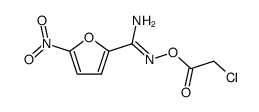5-(chloromethyl)-3-(5-nitrofuran-2-yl)-1,2,4-oxadiazole
Modify Date: 2025-09-27 17:12:13

5-(chloromethyl)-3-(5-nitrofuran-2-yl)-1,2,4-oxadiazole structure
|
Common Name | 5-(chloromethyl)-3-(5-nitrofuran-2-yl)-1,2,4-oxadiazole | ||
|---|---|---|---|---|
| CAS Number | 59-38-1 | Molecular Weight | 229.57700 | |
| Density | 1.569g/cm3 | Boiling Point | 385.1ºC at 760 mmHg | |
| Molecular Formula | C7H4ClN3O4 | Melting Point | N/A | |
| MSDS | N/A | Flash Point | 186.7ºC | |
| Name | 5-(chloromethyl)-3-(5-nitrofuran-2-yl)-1,2,4-oxadiazole |
|---|---|
| Synonym | More Synonyms |
| Density | 1.569g/cm3 |
|---|---|
| Boiling Point | 385.1ºC at 760 mmHg |
| Molecular Formula | C7H4ClN3O4 |
| Molecular Weight | 229.57700 |
| Flash Point | 186.7ºC |
| Exact Mass | 228.98900 |
| PSA | 97.88000 |
| LogP | 2.49980 |
| Index of Refraction | 1.569 |
| InChIKey | JZCVLTRZILOYCD-UHFFFAOYSA-N |
| SMILES | O=[N+]([O-])c1ccc(-c2noc(CCl)n2)o1 |
Synonym:1,3 Diaminobenzen Section 2 - COMPOSITION, INFORMATION ON INGREDIENTS
Risk Phrases: 23/24/25 Section 3 - HAZARDS IDENTIFICATION EMERGENCY OVERVIEW
Toxic by inhalation, in contact with skin and if swallowed. Potential Health Effects Eye: Causes severe eye irritation. May result in corneal injury. Skin: May cause skin irritation. May be absorbed through the skin in harmful amounts. Ingestion: May cause irritation of the digestive tract. May cause liver and kidney damage. May be harmful if swallowed. Inhalation: Dust is irritating to the respiratory tract. Chronic: Prolonged or repeated skin contact may cause dermatitis. Prolonged or repeated exposure may cause adverse reproductive effects. May cause anemia and other blood cell abnormalities. Section 4 - FIRST AID MEASURES Eyes: Flush eyes with plenty of water for at least 15 minutes, occasionally lifting the upper and lower eyelids. Get medical aid immediately. Skin: Flush skin with plenty of water for at least 15 minutes while removing contaminated clothing and shoes. Get medical aid if irritation develops or persists. Ingestion: Get medical aid. Wash mouth out with water. Inhalation: Remove from exposure and move to fresh air immediately. Get medical aid if cough or other symptoms appear. Notes to Physician: Section 5 - FIRE FIGHTING MEASURES General Information: As in any fire, wear a self-contained breathing apparatus in pressure-demand, MSHA/NIOSH (approved or equivalent), and full protective gear. Extinguishing Media: Use water spray, dry chemical, carbon dioxide, or chemical foam. Section 6 - ACCIDENTAL RELEASE MEASURES General Information: Use proper personal protective equipment as indicated in Section 8. Spills/Leaks: Vacuum or sweep up material and place into a suitable disposal container. Remove all sources of ignition. Section 7 - HANDLING and STORAGE Handling: Use with adequate ventilation. Avoid contact with skin and eyes. Avoid ingestion and inhalation. Storage: Store in a cool, dry place. Store in a tightly closed container. Section 8 - EXPOSURE CONTROLS, PERSONAL PROTECTION Engineering Controls: Use process enclosure, local exhaust ventilation, or other engineering controls to control airborne levels. Exposure Limits CAS# 59-38-1: Personal Protective Equipment Eyes: Wear chemical splash goggles. Skin: Wear appropriate protective gloves to prevent skin exposure. Clothing: Wear a chemical apron. Respirators: Follow the OSHA respirator regulations found in 29 CFR 1910.134 or European Standard EN 149. Use a NIOSH/MSHA or European Standard EN 149 approved respirator if exposure limits are exceeded or if irritation or other symptoms are experienced. Section 9 - PHYSICAL AND CHEMICAL PROPERTIES Physical State: Solid Color: white to light brown Odor: Not available. pH: Not available. Vapor Pressure: Not available. Viscosity: Not available. Boiling Point: Not available. Freezing/Melting Point: 243-246C Autoignition Temperature: Not applicable. Flash Point: Not applicable. Explosion Limits, lower: Not available. Explosion Limits, upper: Not available. Decomposition Temperature: Not available. Solubility in water: Very soluble in water. Specific Gravity/Density: Not available. Molecular Formula: C6H5NHNH2HCl Molecular Weight: 144.5294 Section 10 - STABILITY AND REACTIVITY Chemical Stability: Stable under normal temperatures and pressures. Conditions to Avoid: Incompatible materials. Incompatibilities with Other Materials: Strong oxidizing agents. Hazardous Decomposition Products: Carbon monoxide, carbon dioxide. Hazardous Polymerization: Has not been reported. Section 11 - TOXICOLOGICAL INFORMATION RTECS#: CAS# 59-38-1 unlisted. LD50/LC50: Not available. Carcinogenicity: Phenylhydrazium Chloride - Not listed by ACGIH, IARC, or NTP. Section 12 - ECOLOGICAL INFORMATION Section 13 - DISPOSAL CONSIDERATIONS Products which are considered hazardous for supply are classified as Special Waste and the disposal of such chemicals is covered by regulations which may vary according to location. Contact a specialist disposal company or the local waste regulator for advice. Empty containers must be decontaminated before returning for recycling. Section 14 - TRANSPORT INFORMATION IATA Shipping Name: TOXIC SOLID, ORGANIC, NOS Hazard Class: 6.1 UN Number: 2811 Packing Group: II IMO Shipping Name: TOXIC SOLID, ORGANIC, NOS Hazard Class: 6.1 UN Number: 2811 Packing Group: II RID/ADR Shipping Name: TOXIC SOLID, ORGANIC, NOS Hazard Class: 6.1 UN Number: 2811 Packing group: II Section 15 - REGULATORY INFORMATION European/International Regulations European Labeling in Accordance with EC Directives Hazard Symbols: T Risk Phrases: R 23/24/25 Toxic by inhalation, in contact with skin and if swallowed. Safety Phrases: S 26 In case of contact with eyes, rinse immediately with plenty of water and seek medical advice. S 28 After contact with skin, wash immediately with... S 45 In case of accident or if you feel unwell, seek medical advice immediately (show the label where possible). WGK (Water Danger/Protection) CAS# 59-38-1: No information available. Canada None of the chemicals in this product are listed on the DSL/NDSL list. CAS# 59-38-1 is not listed on Canada's Ingredient Disclosure List. US FEDERAL TSCA CAS# 59-38-1 is not listed on the TSCA inventory. It is for research and development use only. SECTION 16 - ADDITIONAL INFORMATION N/A |
|
~68% 
5-(chloromethyl... CAS#:59-38-1 |
| Literature: Yarovenko; Taralashvili; Zavarzin; Krayushkin Tetrahedron, 1990 , vol. 46, # 11 p. 3941 - 3952 |
|
~% 
5-(chloromethyl... CAS#:59-38-1 |
| Literature: Sherman,W.R.; von Esch,A. Journal of Medicinal Chemistry, 1965 , vol. 8, p. 25 - 28 |
| 1,2,4-Oxadiazole,5-(chloromethyl)-3-(5-nitro-2-furanyl) |
| 5-chloromethyl-3-(5-nitro-furan-2-yl)-[1,2,4]oxadiazole |
| 5-Chloromethyl-3-(5-nitro-2-furyl)-1,2,4-oxadiazole |
| 5-Chlormethyl-3-<5-nito-fur-2-yl>-1,2,4-oxadiazol |
| 5-(Chloromethyl)-3-(5-nitro-2-furanyl)-1,2,4-oxadiazole |


